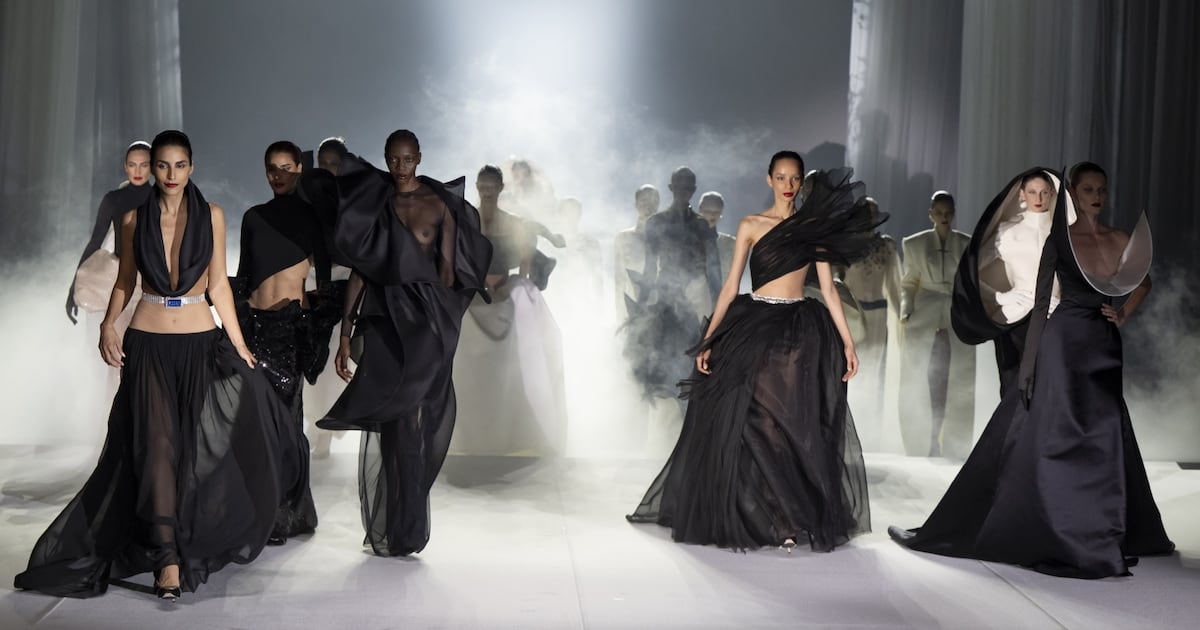PARIS â âNobody needs couture,â said Balenciagaâs Demma at the end of his show on Wednesday. The statement might have summarised the brief couture week (absent were Valentino, Margiela and Fendi) that just ended in Paris, where a sense of creative fatigue permeated the proceedings and what we saw was often monumental yet forgettable. But of course, Demnaâs words were a part of a backstage voiceover on his own collection, and not a critique of the moment.
This was Balenciagaâs fourth couture outing since the house reopened its Avenue George V ateliers. It was also its closest to Demnaâs own subversive aesthetic sensibility. There were hand-painted t-shirts, wide denim pants doubled in scuba silk, dresses jumbled from discarded items of clothing in a couture take on upcycling (that perhaps owed too much to Miguel Adroverâs final collection, âOut of My Mindâ), and a final ephemeral cocoon dress draped on the model. No doubt the collection was impressive in breaking couture norms, but the repetition of now familiar tropes ultimately read as Demna saying, âFuck you, this is what I do,â in keeping with founder Cristobal Balenciagaâs own legendary consistency.
But what left the strongest impression was the sense of sculptural rigidity and a stiff monumentality that was all over Paris. The king of architectural dressing is Daniel Roseberry, who this season at Schiaparelli ditched meme fashion, baroque decoration and the giddy luminosity of the Petit Palais in favour of 1950s nipped waists and body-redesigning constructions, shown in the dark underbelly of the tony Hôtel Salomon de Rothschild. It was an assured outing that feld a less costumey then the past.
A certain stiffness is part of the Thom Browne language, both in the symbolic outline of his world and in the regimented way it is presented. As much as the Thom Browne uniform is one of fashionâs most singular and striking propositions, his overtly theatrical shows can be gruelling. This season, working with tailoring canvas and exploring ideas of finished and unfinished, Browne paid homage to the atelier: there were certainly masterpieces of savoir faire on display, but the message felt convoluted.
Eternal absurdists Viktor & Rolf belong to the school of fashionâs stiff thinkers, too, but what saves them is their sardonic humour and concision: they usually deliver a message in the span of twenty or so, faultless silhouettes. This season, the goings got angular and boxy, in a celebration of prismatic shapes and garish colour suspended halfway between Klaus Nomi and Spongebob, with some Liquid Sky and Cinzia Ruggeri thrown in for good measure. It was a blast, but the strobe lighting was de trop.
This was a season of monumentalism â unabashed or tamed. The Chanel show, the first since Virginie Viardâs departure and most likely based on a collection she partially worked on, was held in the splendour of the Paris Opera. Despite following a rather predictable operatic theme, complete with cloaks, bustiers, bows and other Madame de Pompadour theatrics, it was a taut, cohesive outing, and the demonstration that Chanel has such a strongly defined code that it can keep going for a while without a creative director.
Charles de Vilmorin is into theatrics, too, of the flamboyant, over-the-top variety. The bourgeois drama he envisioned felt a little homemade at times, but it had lots of energy. It was at Jean Paul Gaultier Haute Couture, however, that the architecture of dressing got a captivating, seductive spin through the vision of Courrèges designer Nicolas Di Felice. The merging of Gaultierâs Parisian cheekiness and Di Feliceâs own taste for raw, sex-charged linearity translated into an unexpected take on the labelâs heritage, not a single conical breast or guêpière in sight. Instead, Di Felice, who is firmly averse to useless decoration, used hook and eye closures as functional embroidery that allows one to drape pieces, or to open them at will. It made for a mixture of sharpness and abandon that felt fresh.
And yet it were the designers working around notions of lightness that offered a take on couture that felt plausible past the visual feast. Their collections werenât the most engaging, but they had purpose and showed the true skills of the ateliers: those that beautify women of any age and shape. Rather predictably in the year of the Olympics, Diorâs Maria Grazia Chiuri worked around a classic Olympic theme, exploring notions of draping much with a Madame Grès kind of dedication. It made for a consistent outing that felt heroic in its disdain for theatrics.
Giambattista Valli finally ditched the tulle and the meringues and went flou all the way, toying with an Indian palette of pastel tones that was a joy to behold. Meanwhile, on the verge of turning 90 on July 11th, Giorgio Armani delivered a glistening take on restraint. The collection was a little sprawling, but when it stuck to liquid tailoring and elongated dressing in wonderfully subtle pearly embroidery and hues, it was a testament to the virtue of restraint, which is more relevant now than ever.

